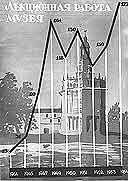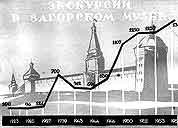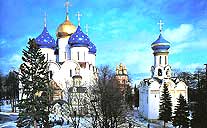History of the Educational Activity (page 2)
 In the late 1940s, they worked out the first methodical recommendations for all expositions. The were composed of the excursion texts, definition of the aim and ideological recommendations. At the same time they wrote recommendations for the excursions for junior schoolchildren of the third and fourth forms. Some of them were in the form of questions and answers.
In the late 1940s, they worked out the first methodical recommendations for all expositions. The were composed of the excursion texts, definition of the aim and ideological recommendations. At the same time they wrote recommendations for the excursions for junior schoolchildren of the third and fourth forms. Some of them were in the form of questions and answers.
 In 1951, the Department of the Scientific Popularization of Art was established. The Regulations of the Zagorsk State History and Art Museum-Reserve, adopted by the Committee on Art of the USSR Soviet of Ministers, determined the main forms of its activity: excursions, lectures, clubs, consultations and seminars for schoolchildren and teachers.
In 1951, the Department of the Scientific Popularization of Art was established. The Regulations of the Zagorsk State History and Art Museum-Reserve, adopted by the Committee on Art of the USSR Soviet of Ministers, determined the main forms of its activity: excursions, lectures, clubs, consultations and seminars for schoolchildren and teachers.
 In the 1960s, the educational work was based on the various new expositions: History of the Trinity-St. Sergius Monastery, its Necropolis, Architectural Ensemble and Methods of its Restoration, Old Russian Painting, Old Russian Applied Art, Russian Art of the 18th – 19th Centuries, Russian Folk Art, Contemporary Applied and Decorative Art. The expositions were housed in 40 halls of the floor square of 4.500 sq. m
In the 1960s, the educational work was based on the various new expositions: History of the Trinity-St. Sergius Monastery, its Necropolis, Architectural Ensemble and Methods of its Restoration, Old Russian Painting, Old Russian Applied Art, Russian Art of the 18th – 19th Centuries, Russian Folk Art, Contemporary Applied and Decorative Art. The expositions were housed in 40 halls of the floor square of 4.500 sq. m
 In 1969, at the Conference dedicated to the 100th anniversary of V.I. Lenin, when the results of the Museum activity were discussed, they touched upon the problems of educational work for the first time. The significance of the Museum in propaganda of national art was stressed in 1969, when Zagorsk was included into the all-union tour of Old Russian towns called “The Golden Ring”. Since that time, the number of visitors constantly grew reaching 700.000 in 1979. The main task of the educational service was to receive travelers, so review tours for adults were organized.
In 1969, at the Conference dedicated to the 100th anniversary of V.I. Lenin, when the results of the Museum activity were discussed, they touched upon the problems of educational work for the first time. The significance of the Museum in propaganda of national art was stressed in 1969, when Zagorsk was included into the all-union tour of Old Russian towns called “The Golden Ring”. Since that time, the number of visitors constantly grew reaching 700.000 in 1979. The main task of the educational service was to receive travelers, so review tours for adults were organized.
|


